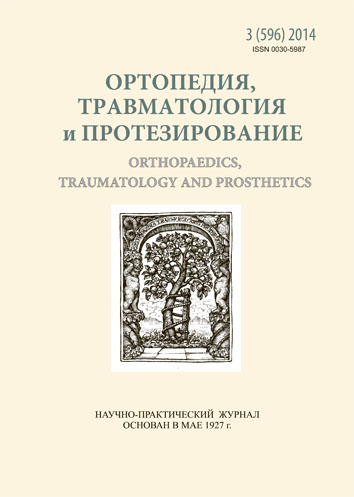Proximal femoral corrective osteotomies from the standpoint of subsequent arthroplasty (view on the problem)
DOI:
https://doi.org/10.15674/0030-598720143122-128Keywords:
intertrochanteric osteotomy, complicated artroplasty, hip jointAbstract
Every year in the world they perform about 1 million of total hip replacements (THR). In 6–10 % of patients with pathology of this joint they observe significant violations of configuration of the articular surface in the form of deformities and defects. Destructive changes in the hip joint (HJ) are also associated with proximal femoral corrective osteotomies (PFCO) and require THR. During reconstructive surgery it is necessary to restore normal anatomic relationships between the bone structures that form the HJ. This is due to physiological biomechanics of movement in the HJ which is possible just upon condition of restoration of its anatomical shape. In this paper we assessed the impact of PFCO in adults to possible further implantation of the endoprosthesis taking into account some technical features of surgery. It was established that PFCO in adults cause significant changes in the anatomical shape of the proximal femur manifesting with polygonal deformations of metaepiphysis and medullary canal. Pathological restructuring of bone structures associated with overgrowth medullary canal at the level of osteotomy and the formation of zones of local osteoporosis or cavities in the proximal metaepiphysis. These factors contribute to adverse outcomes for individual THR which is displayed in a large number of early postoperative complications due to the instability of the endoprosthesis' components. However one should note that in the last decade possibilities of diagnostic equipment significantly increased which creates prerequisites for early diagnosis of degenerative joint diseases at a new level. In this regard renaissance of reconstructive surgeries on the HJ is quite possible.
References
- Bombelli R. Ostearthritis of the hip: pathologenesis and consequent therapy / R. Bombelli. — Berlin: New York: Springer-Verlag, 1983. — 386 p.
- Cabanela M M . E. Proximal femoral deformity: bent but not broken / M. E. Cabanela // Orthopedics. — 2004. — Vol. 27, № 9. — P. 953–954.
- Porcher R. Reporting results of orthopaedic research: confidence intervals and values / R. Porcher // Clin. Orthop. Rel. Res. — 2009. — Vol. 467 (10). — P. 2736–2737.
- Ochsner P. E. Total hip replacement / P. E. Ochsner. — Berlin: Springer, 2003. — 243 p.
- Pauwels F. Biomechanics of the locomotor apparatus / F. Pauwels. — New York: Springer-Verlag, 1980. — 532 p.
- Schatzker I. The intertrochanteric osteotomy / I. Schatzker. — Berlin: Springer Verlag, 1984. — 201 p.
- Shigematsu M M . Total hip arthoplasty after revision proximal femoral osteotomy / M. Shigematsu, T. Hotokebuchi // Clin. Calcium. — 2007. — Vol. 17, № 6. — P. 947–953.
- Spotorno L. The CLS uncemented total hip replacement system / L. Spotorno, S. Romagnoli. — Thun: Werbelinie AG, 1991. — 26 p.
- Total hip arthroplasty after previous transtrochanteric anterior rotational osteotomy for femoral head osteonecrosis / Lee Young-Kyun, Ha Yong-Chan, Kim Ki-Choul [et al.] // J. Arthroplasty. — 2009. — Vol. 5. — P. 1205–1209.
- Weisl H. Intertrochanteric osteotomy for osteoarthritis. A long-term follow-up / H. Weisl // J. Bone Joint Surg. — 1980. — Vol. 62-B. — P. 37–42.
Downloads
How to Cite
Issue
Section
License
Copyright (c) 2014 Oleksandr Oleynik

This work is licensed under a Creative Commons Attribution 4.0 International License.
The authors retain the right of authorship of their manuscript and pass the journal the right of the first publication of this article, which automatically become available from the date of publication under the terms of Creative Commons Attribution License, which allows others to freely distribute the published manuscript with mandatory linking to authors of the original research and the first publication of this one in this journal.
Authors have the right to enter into a separate supplemental agreement on the additional non-exclusive distribution of manuscript in the form in which it was published by the journal (i.e. to put work in electronic storage of an institution or publish as a part of the book) while maintaining the reference to the first publication of the manuscript in this journal.
The editorial policy of the journal allows authors and encourages manuscript accommodation online (i.e. in storage of an institution or on the personal websites) as before submission of the manuscript to the editorial office, and during its editorial processing because it contributes to productive scientific discussion and positively affects the efficiency and dynamics of the published manuscript citation (see The Effect of Open Access).














